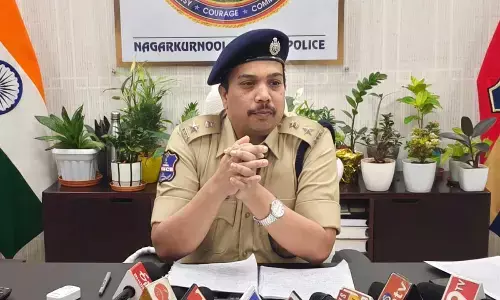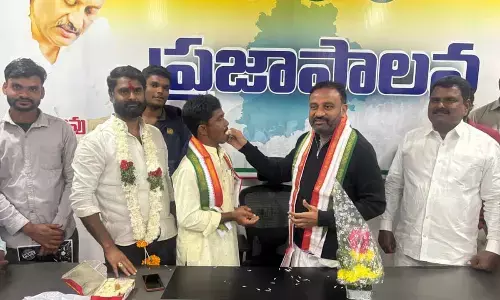Sangameshwara Swamy temple rarely visible

Sangameshwara Swamy temple rarely visible
The Sangameshwara Swamy Temple, sacred and holy shrine dedicated to Lord Shiva is rarely visible and generally submerged in the holy waters of Krishna River the famous shrine is located 40 kilometers away from Atmakur and 120 kilometers from Kurnool main town
The Sangameshwara Swamy Temple, sacred and holy shrine dedicated to Lord Shiva is rarely visible and generally submerged in the holy waters of Krishna River the famous shrine is located 40 kilometers away from Atmakur and 120 kilometers from Kurnool main town. The shrine is considered to, the north-west gateway of Srisailam and the 2nd among the 12 Jyotirlinga and at the confluence of seven rivers, Krishna, Veni, Tungabhadra, Bheemraadi, Malapaahini, Sangameswara and Bhavanasani Rivers.
The Krishna, Veni, Bheemaradhi, Malapaharani forms at Alamatti Dam thereby reaches Alampur passing through Narayanapur and Jurala. The Karnataka government has constructed one Sangameshwara temple in Alamatti dam and has facilitated the devotees to the darshan even in full waters. Two more rivers, Tunga and Bhadra which form in Shivamogga in Sringeri in Karnataka, will also reach Alampur passing through Thungabhadra Dam Humpi and Mantralayam.
The six rivers will merge at Alampur, which is called as Shannadi Sangamam (confluence of six rivers). These six rivers are called Nadhulu (female) as they flow from West to East. One more Sangameshwara temple was constructed at the confluence of six rivers near Undavalli and Kudavelli villages, but it was shifted to Alampur by the Archeological department. Another river, Bhavanasini which forms at Ahobilam in Allagadda will join the six rivers at Sangameshwar. This is Male River and is known as Nadhamu, which flows from East to West. With the joining of Bhavanasini,Sapta Nadula Sangamam, Sangameshwaram was formed. Across the country there is no confluence of seven rivers. It is only found in Kurnool district of Andhra Pradesh state.
Apart from Sapta Nadula Sangamam, 11 more teerthas, Devadroni, Bhujanga, Banuka, Dasasuvameda, Saptakoteeshwara, Gayathri, Chakratheertha and others are in Sangameswaram. The goddess will take a holy bath in Devadroni and offer prayers to Lord Shiva. During Dwapara Yugam, after completion of exile, the Pandavas also visited this area. After visiting Sangameswaram and following the directions of Lord Krishna, the Pandavas established Shiva Lingas.
Following the orders of Lord Krishna, Yudhistar the elder brother of Pancha Pandavas directs Bheema to bring Shiva Lingam from Kasi. On finding Bheema could not arrive in time, Yudhistar prepared Shiva Lingam out of Neem stump and established it in the river confluence which later became famous as Sangameshwaram Swamy. This incident dates back to 5100 years. Bheema who arrives late knows about the establishment of Shiva Lingam. He gets angry and throws the Shiva Lingam in the confluence. Yudhistara established the thrown Shiva Lingam on the river bank and named it Bheema Lingam.
The Lingas brought by Bheema were formed as Siddeshwaram, Malleshwaram, Kapleeshwaram, Someshwaram and Sangameshwara. Malleshwaram and Someshwaram are now in Telangana state and the remaining three are in Rayalaseema region. Someshwaram in Telangana is also known as Somasila. The Telangana government has well developed the areas as a tourism spot. Every day, on an average, hundreds of pilgrims visit the Someshwaram pilgrimage.
The pilgrims that visit Someshwaram will also visit Srisailam through boat facility, thrice in a week. In the 11th century, the descendents of Kalyani Chalukyas have widely developed the Sangameshwara temple established by Dharma Raju (Yudhistara). 3000 acres of endowment land was allocated for performing prayers and others to Sangameshwara Swamy temple.
The temple was submerged under water for a period of 23 years (from 1981 to 2003). Six more sub temples, Narasimha Swamy temple, Shanmukha Subramanya Swamy temple, Vazra Lingeshwara Swamy temple, Surya Narayana Swamy temple, Lakshmi Sathyanarayana Swamy temple and Gayathri temple could be seen along with the main Sangameshwara Swamy temple which is widely spread 10 thousand feet. Even the steps leading to Bheema Lingam swamy temple could also be seen.
The historical temple could be visible when the water level in Srisailam Dam recedes to 790 to 800 feet. The flood water enters into Gharba Alayam if the water level is registered to 830 feet and the Shikaram will submerge when the water level is 840 to 860 feet. Earlier there was a rock chariot which is now shifted to Jagannadha Gattu. The chariot was designed by the descendants of Kalyani Badami Chalukyas. The same temple design could be seen in Karnataka state.
The Sangameswaram is also known as Nivurithi Sangamam because Parvathi Devi has self immolated during Daksha Yagana. It is believed that Daksha Prajapathi performed Yagna in this place and Daksha insulted Parvathi and Shiva in the Yagna. Parvathi started yoga which is not possible to the Yogis moving her five elements from their origin. Fire erupted and Parvathi self immolated in the fire. Since the soul of Parvathi Devi was released from her body here with which the place is also called as Nivruthi Sangameswaram.
In other form it is also known as Nivruthi Bhaskara Sangamam because the Shandilya Maharshi has bestowed the Lord Suryanarayana Swamy after decades of penance. Even Vishwamitra has also penance for 60000 years to get the blessings of Gayathri Devi enabling him to free from the leprosy disease, Gayathri Gow pada mudrika could also be seen.
The Bharadwaja Maharshi also performed Pinda Pradaman to his fore father with curd rice near Bheema Lingam and relieved them from Sajjo Mukthi. Vasista Maharaja also visited Sangameswaram and offered prayers to Lakshmi Narasimha Swamy.
The temple will submerge in Krishna River throughout the year and appears in few months to reach with great difficulty.
Thousands of devotees will reach the temple facing the difficulty to visit the Holy Shrine. The holy place is the confluence of seven rivers and is famous as Sapta Nadi Sangameswaram (seven rivers confluence). The temple would be submerged in the flood water for a period of 8 months and visible for 4 months. The temple has great historical importance and given shelter to so many sages.
The main priest of Sangameshwara temple, Telakapalli Raghu Rama Sharma told The Hans India that every year the temple would be submerged in Krishna River for a period of 8 months. The temple would be again visible for a period of 4 months when the water recedes to 790 to 800 feet in Srisailam Dam.
The Sangameshwaram Swamy temple has great importance as it is constructed on the confluence of seven rivers. There is only Triveni Sangamam in the country but it doesn't have Sapta Nadula Sangamam. It could be only seen in Kurnool district of Andhra Pradesh state, said Telkapalli Raghu Rama Sharma.


















